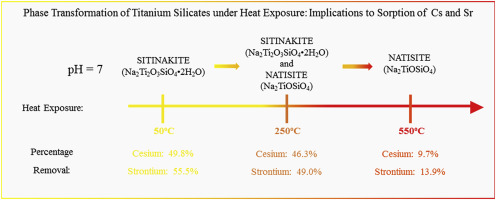Microporous and Mesoporous Materials ( IF 5.2 ) Pub Date : 2019-12-30 , DOI: 10.1016/j.micromeso.2019.109995 Seth R. Gainey , Matheus T. Lauar , Christopher T. Adcock , Jacimaria R. Batista , Kenneth Czerwinski , David W. Hatchett

|
The remediation of radioactive isotopes such as Cs+ and Sr2+ from water has been evaluated using sitinakites. The sorption media employed in the remediation of radioactive wastes must have thermal and chemical stability to be useful. The present study investigates the structural stability and adsorption performance of sitinakites under conditions of elevated temperatures between 50 and 550 °C. X-ray diffraction indicates that major structural changes are initiated with heating, reducing the crystallinity of the material. The FTIR results also indicate that simultaneous and irreversible dehydration of the materials occurs with elevated temperatures under the conditions studied. Thermal processing also influences the sorption of Cs+, which decreases rapidly as the temperature increases. Adsorption was reduced by 80% at 550 °C for Cs+, when compared to the material processed at 50 °C and neutral pH. In contrast, the sorption of Sr2+ decreases substantially only when the processing temperature reaches 550 °C under the same solution conditions. In addition, the sorption of Cs+ and Sr2+ follow different trends as functions of pH after thermal treatment. The sorption of Cs+ decreases as a function of increased processing temperature and higher alkalinity. In contrast, the sorption of Sr2+ decreases with thermal processing; however, overall Sr2+ sorption increases as the pH becomes more alkaline. The sorption differences suggest that Cs+ uptake is structurally driven, while Sr2+ sorption is influenced by both the structure and the surface electrostatics of the material. These results suggest the effectiveness of the materials may be compromised when processed or exposed to elevated temperatures due to changes in structure, hydration, and electrostatic interactions.
中文翻译:

热处理对硅铁矿吸附Cs和Sr的影响
已经使用硅铁矿对从水中对放射性同位素(例如Cs +和Sr 2+)的修复进行了评估。放射性废物修复中使用的吸附介质必须具有热稳定性和化学稳定性才能使用。本研究研究了在50至550°C的高温条件下硅铁矿的结构稳定性和吸附性能。X射线衍射表明,主要结构变化是通过加热引发的,从而降低了材料的结晶度。FTIR结果还表明,在所研究的条件下,随着温度的升高,材料会同时发生不可逆的脱水。热处理也会影响Cs +的吸附,随着温度的升高迅速降低。与在50°C和中性pH下处理的材料相比,在550°C下Cs +的吸附降低了80%。相反,只有在相同的溶液条件下处理温度达到550°C时,Sr 2+的吸附量才会显着降低。此外,热处理后,随着pH的变化,Cs +和Sr 2+的吸附遵循不同的趋势。Cs +的吸附量随加工温度升高和碱度升高而降低。相反,Sr 2+的吸附随着热处理而降低;但是,总体Sr 2+随着pH值变得更碱性,吸附增加。吸附差异表明Cs +的吸收受结构驱动,而Sr 2+的吸附受材料的结构和表面静电影响。这些结果表明,由于结构,水合和静电相互作用的变化,当加工或暴露于高温下时,材料的有效性可能会受到损害。


























 京公网安备 11010802027423号
京公网安备 11010802027423号